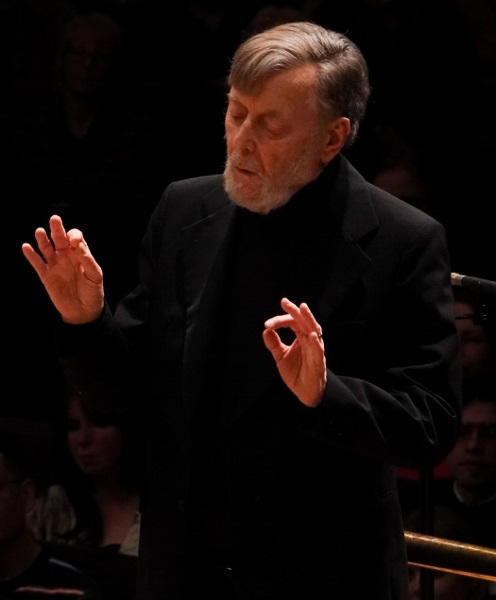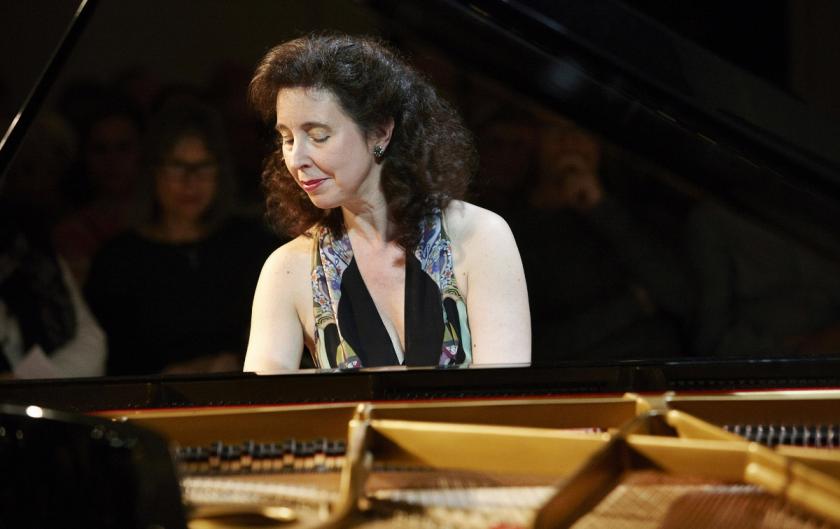Two intriguing themes and two great guest artists were offered by the BBC Philharmonic to their Saturday night audience in the Bridgewater Hall: the themes were what “classicism” really is, and the variety of music inspired by (or written for) dance.
The artists were Angela Hewitt, soloist in Mozart’s Piano Concerto No. 23, and Sir Andrew Davis, making another welcome visit to Manchester. You might say that a third theme of the evening was the chance to see the two of them deliver a masterclass in piano playing and orchestral conducting.
Classicism, then: what is it? Whole books have been written about that subject, but a starting point could be to say that the aesthetic values of the past can be a guide to creativity in later times. Thus Ravel’s Le Tombeau de Couperin, a homage to the great 17th century French composer that was written during the First World War, took elements from the dance suite format of French baroque keyboard music and made them thoroughly up-to-date. In the orchestral version they give the players a chance to shine, not only by demonstrating sleek virtuosity but also in catching the sense of a slightly hazily glimpsed golden past.
Under Sir Andrew’s direction, the wind players opened the Prélude in precisely that vein, and the strings soon caught up with them. Davis balances his string forces with care: in this case the first and second violins were equal in number in an overall team of just fewer than 40. The Forlane (the first of three dances) was dainty, delicate and poised, the Menuet mysteriously veiled except for rare (but therefore highly effective) bursts of intensity, and the Rigaudon lively at the beginning and end, but gentler and quite elegiac in its middle section.
 The strings were reduced further for the Mozart concerto, so it was definitely a “classical” orchestra for that, but there was no lack of tone from them, and, with Zoe Beyers their leader, there was really beautiful articulation from the start. Sir Andrew (pictured right) knows how a Mozart orchestra should sound: clear and well proportioned, with contrast amply delineated – in this case, dramatically so in the closing themes of the opening ritornello – which is another aspect of the classical style. Angela Hewitt was with him there, and she found a subtle depth of expression in the second subject that only an expert soloist can provide, and let herself go when the time came in the fiery cadenza (Mozart’s own). In the second movement she pedalled just the minimum necessary to enhance her cantabile on the opening melody, and the wind “Harmonie” serenaded gloriously. Chattering clarinets brought an operatic sense of fun to the finale, and at the end the tutti completed the concerto’s dynamic arc, bringing the tonal weight of the opening back to the fore.
The strings were reduced further for the Mozart concerto, so it was definitely a “classical” orchestra for that, but there was no lack of tone from them, and, with Zoe Beyers their leader, there was really beautiful articulation from the start. Sir Andrew (pictured right) knows how a Mozart orchestra should sound: clear and well proportioned, with contrast amply delineated – in this case, dramatically so in the closing themes of the opening ritornello – which is another aspect of the classical style. Angela Hewitt was with him there, and she found a subtle depth of expression in the second subject that only an expert soloist can provide, and let herself go when the time came in the fiery cadenza (Mozart’s own). In the second movement she pedalled just the minimum necessary to enhance her cantabile on the opening melody, and the wind “Harmonie” serenaded gloriously. Chattering clarinets brought an operatic sense of fun to the finale, and at the end the tutti completed the concerto’s dynamic arc, bringing the tonal weight of the opening back to the fore.
She added to that a vigorous solo encore in the shape of the Rondo all Turca – why not, as it’s Mozart and in the right key? – much appreciated by all present.
Over to Stravinsky for much of the second part of the concert. This was, first, the Stravinsky of 1917 (though he didn’t orchestrate the piece until 1925) in his Suite No. 1. Its four movements take only five minutes all told, and don’t take themselves too seriously, but they were played with impressive rhythmic precision, as befits their dance-like quality.
With Apollon Musagète in the later 1920s, Stravinsky was writing for professional ballet performers (under the direction of the young Balanchine) and had gone rather further down the road of his own neo-classicism. The strings in this homage to classical antiquity and the Greek mythology of Apollo and the Muses are on their own, with player numbers exactly specified, including two groups of four cellos as well as those in the other voices similar to the Mozart band we’d just heard. The sound they make, however, is not a bit like Mozart: it could almost be late-Romantic, with a wistful, nostalgic quality in the opening, and proved a bit of a test for the Philharmonic’s players at the very start, though they grew more assured with every bar. Zoe Beyers’ solo for the first Apollo Variation was a delight, and the remaining numbers were engagingly characterised, with a spring in their step for Terpsichore and warmth and resonance for the second Apollo Variation, energy and joy in the Coda and a richly evocative Apotheosis. The highspot of them all, though, was the balanced and precise Pas de Deux. Stravinsky’s approach to the “classical”, attempting to re-create the idealism of the ancients, was a different thing from Mozart’s or Ravel’s, but it received its richest expression as that piece was played.
It was Ravel again to finish, though this time hardly classical in any sense: instead, all hands on deck (and the BBC Philharmonic in this mode is a very big orchestra) for a coruscating account of La Valse. It’s a showstopper in any programme: on this occasion Sir Andrew Davis sustained the refined sounds of the earlier items in his programme long enough to expose soloistic effects delightfully (I loved the sound of the bass clarinet gurgling away in the nether regions like a bit of bad plumbing) and to enable him to build a superb crescendo to the end of the first part of the piece. His tempo was brilliantly flexible, enabling the music to ebb and flow and trickle and surge, and then, as the grim apotheosis neared, it became terrifyingly relentless and grindingly overwhelming. Quite an experience.














Add comment